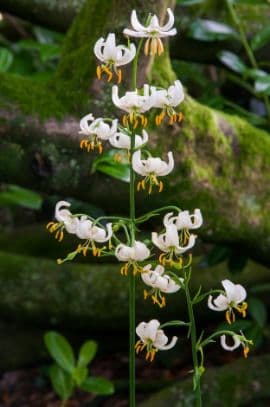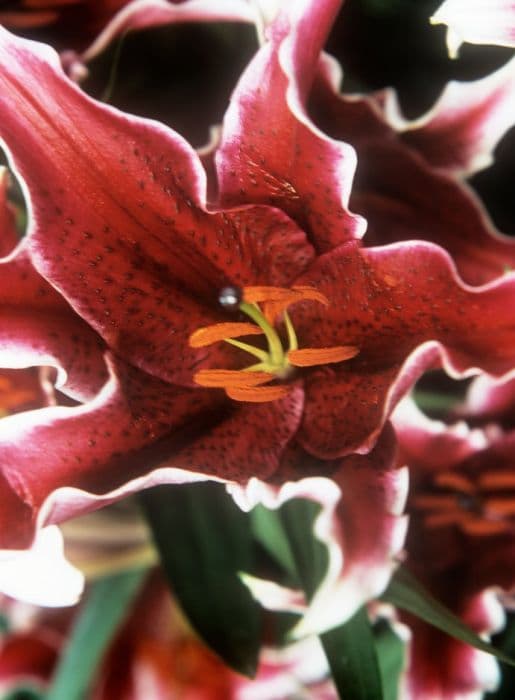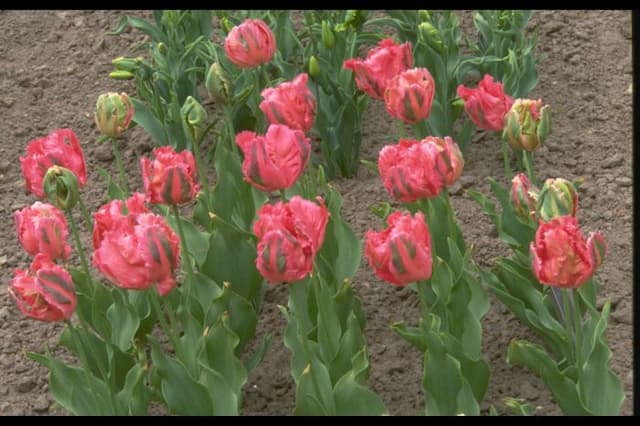Tulip Tulipa 'Canasta' (7)

ABOUT
The Tulipa 'Canasta' is a striking variety of tulip known for its unique and captivating appearance. The plant features showy, bowl-shaped flowers with a distinctive fringed edge that gives them a ruffled look. The petals are vividly colored, with a bold, two-toned pattern. The base color is typically a vibrant red or deep pink, which is then beautifully contrasted with white edges that create an eye-catching effect. The leaves of the Tulipa 'Canasta' are green and have a lance-shaped, smooth appearance which complements the flowers well. Each stem typically bears a single large flower that serves as a focal point in any garden setting. This tulip variety blooms in the springtime, offering a brilliant display of color when many other plants are only beginning to wake from their winter slumber. A cultivated variety, the Tulipa 'Canasta' is popular among gardeners and landscapers for its ornamental value. It is often planted in clusters or rows within garden beds, borders, and containers, where the fringed blossoms can stand out and add texture to the floral arrangement. Its lush and vibrant flowers also make it a favorite choice for cut floral arrangements, bringing a piece of spring's splendor into the home.
About this plant
 Names
NamesFamily
Liliaceae
Synonyms
Canasta Tulip
Common names
Tulipa 'Canasta'
 Toxicity
ToxicityTo humans
The plant commonly known as Tulip is not highly toxic to humans, but it does contain compounds that can cause irritation and discomfort if ingested in large quantities. Eating parts of the Tulip, especially the bulb, can lead to symptoms such as nausea, vomiting, abdominal pain, and diarrhea. It is essential to avoid ingesting any part of the Tulip to prevent these potential negative health effects.
To pets
For pets, especially cats and dogs, Tulips are considered toxic. The plant contains allergenic lactones and other alkaloids, primarily concentrated in the bulbs. If a pet chews on or ingests parts of a Tulip, particularly the bulb, they may experience symptoms such as gastrointestinal irritation, drooling, loss of appetite, depression of the central nervous system, convulsions, and even cardiac abnormalities. In severe cases, ingesting Tulip bulbs could potentially lead to death, and veterinary attention should be sought immediately if a pet is suspected to have ingested any part of the plant.
 Characteristics
CharacteristicsLife cycle
Perennials
Foliage type
Deciduous
Color of leaves
Green
Flower color
Red
Height
1-2 feet (30-60 cm)
Spread
0-1 feet (0-30 cm)
Plant type
Bulb
Hardiness zones
3
Native area
Central Asia
Benefits
 General Benefits
General Benefits- Attracts Pollinators: Tulipa 'Canasta', commonly known as fringed tulip, attracts bees and other pollinators, contributing to the health of your garden's ecosystem.
- Colorful Blooms: The fringed petals of the fringed tulip add a striking visual display to gardens and landscapes, with vibrant colors that can enhance the beauty of any space.
- Easy to Grow: Fringed tulips are relatively easy to cultivate in well-drained soil and full sun, making them a low-maintenance option for gardeners of all skill levels.
- Spring Interest: Blooming in the spring, fringed tulip provides early seasonal interest after the long winter months, often being one of the first flowers to emerge.
- Cut Flower Garden: Fringed tulips are excellent for cut flower gardens, as they have sturdy stems and long vase life, bringing the beauty of spring indoors.
- Varied Landscaping Uses: Tulipa 'Canasta' can be used in a variety of landscaping schemes, including borders, containers, and rock gardens, offering flexibility in garden design.
- Seasonal Festivity: Often associated with spring holidays and events, fringed tulips can contribute to the festive atmosphere during these times, making them popular for seasonal decorations.
 Medical Properties
Medical PropertiesThis plant is not used for medical purposes.
 Air-purifying Qualities
Air-purifying QualitiesThis plant is not specifically known for air purifying qualities.
 Other Uses
Other Uses- Art and Craft Inspiration: The vibrant colors and unique fringed edges of the tulip 'Canasta' can inspire artists and crafters in their work, serving as a subject for paintings, drawings, or textile designs.
- Photography: Because of their striking appearance, 'Canasta' tulips are often used as a focus for professional and amateur photographers looking to capture the essence of spring and natural beauty.
- Educational Tools: These tulips can be used in schools or educational programs to teach students about plant biology, hybridization, and the life cycle of flowers.
- Event Decorations: The flowers can be used for decorating venues for special events such as weddings, parties, and corporate functions, lending an elegant and colorful touch.
- Color Dye: Petals of the 'Canasta' tulip may be boiled to extract natural dyes for fabrics or paper, although this is not a common practice.
- Culinary Garnish: The petals, while not commonly consumed, can be used as an edible garnish for salads and desserts, adding a splash of color to dishes.
- Fragrance Extraction: While not a traditional source for perfume, the scent of tulips could be captured and used in making homemade fragrances or potpourri.
- Environmental Education: The ‘Canasta’ variety can be used to teach about biodiversity and the impact of climate change on the flowering and growth patterns of plants.
- Cultural Festivals: These tulips can be a centerpiece in festivals or cultural celebrations, especially those celebrating spring and floral beauty.
- Floral Arranging Classes: Florists or educators can use 'Canasta' tulips in workshops to teach about flower arranging techniques and principles of design.
Interesting Facts
 Feng Shui
Feng ShuiThe Tulip is not used in Feng Shui practice.
 Zodiac Sign Compitability
Zodiac Sign CompitabilityThe Tulip is not used in astrology practice.
 Plant Symbolism
Plant Symbolism- Perfect Love: Tulips, in general, symbolize perfect love. The 'Canasta' variety with its distinctive ruffled edges and vibrant colors could be said to represent a more elaborate or expressive form of love.
- Rebirth: As a herald of spring, the tulip often represents rebirth and new beginnings. The 'Canasta' variety may signify an even more exceptional or awaited new start, given its striking appearance.
- Charity: Tulips can also be a symbol of charity, where their open form is seen as a gesture of giving. 'Canasta' tulips might exemplify this with their large, open blooms.
- Eternal Life: Tulips have been seen to symbolize eternal life, particularly in religious contexts. The 'Canasta' with its long-lasting blooms may echo this sentiment.
- Royalty: The bold colors and unique forms of 'Canasta' tulips can indicate royalty or a regal bearing, reflecting the storied history of tulipomania and their value in the past.
- Fame: As tulips can also symbolize fame or the perfect lover, the 'Canasta' variety might be associated with the notoriety of its beauty and its standout nature in a garden.
- Prosperity: During the height of the tulip's popularity in Holland, they were worth a great deal of money, leading to the association with prosperity, an attribute that 'Canasta' tulips, with their luxurious look, continue to embody.
 Water
WaterTulip 'Canasta' needs regular watering during the growing season, which is typically in the spring. It's important to keep the soil evenly moist but not waterlogged. Providing about an inch of water weekly, either through rainfall or manual watering, is sufficient. During the dormancy period in the summer, when the foliage has died back, watering should be reduced significantly. Ensure that the plant receives less than a gallon of water every few weeks during this rest period to prevent bulb rot.
 Light
LightTulip 'Canasta' thrives best in full sun to light shade locations. The plant ideally needs at least six hours of direct sunlight per day. Positioning it in a spot where it can receive ample morning sunlight with some afternoon shade is beneficial, especially in hotter climates to prevent the flowers from fading quickly.
 Temperature
TemperatureTulip 'Canasta' can withstand winter temperatures as low as 14°F but should not be exposed to prolonged periods of freezing conditions without protective mulch. The ideal growing temperature for tulips is between 50°F and 65°F during their growing season. Bulbs require a period of cold dormancy at 35°F to 45°F to bloom properly.
 Pruning
PruningTulip 'Canasta' typically does not require much pruning, but deadheading the spent blooms immediately after they fade helps redirect energy to the bulb rather than seed production. Removal of the flower stems should be done once they've yellowed and withered. Leave the foliage until it dies back naturally as it helps replenish nutrients for next year's growth.
 Cleaning
CleaningAs needed
 Soil
SoilFringed tulips like 'Canasta' thrive in well-draining, fertile soil with a pH between 6.0 and 7.0. A mix of equal parts loam, sand, and compost or well-rotted manure promotes healthy growth. Ensure adequate drainage to prevent bulb rot.
 Repotting
RepottingFringed tulips such as 'Canasta' are typically grown from bulbs which do not require repotting. Instead, bulbs should be planted annually in the fall, 4-6 inches deep, depending on the size of the bulb.
 Humidity & Misting
Humidity & Misting'Canasta' fringed tulips prefer average outdoor humidity levels. They are adaptable and do not require special humidity considerations as long as natural rainfall provides sufficient moisture.
 Suitable locations
Suitable locationsIndoor
Plant 'Canasta' fringed tulip bulbs in pots with drainage and ample light.
Outdoor
Plant bulbs in autumn, full sun to partial shade, in well-drained soil.
Hardiness zone
3-8 USDA
 Life cycle
Life cycleThe life of the Tulip 'Canasta', commonly known as Fringed Tulip, begins with the planting of the bulb in fall, which requires a period of cold dormancy to spark growth. As spring arrives, the bulb breaks dormancy and roots start to develop, quickly followed by the shoot that emerges from the soil. The plant grows rapidly, producing distinctive fringed leaves and a strong stem that leads to the blooming of its vibrant, fringed flowers in mid to late spring. After flowering, the tulip enters a senescence phase; the petals fall, and the plant begins to divert energy back into the bulb for the next season. The foliage dies back by early summer, and the bulb remains dormant underground until the following fall. For the plant to continue its life cycle annually, it is important that the bulb is undisturbed during its dormancy and that it receives adequate chilling to meet its required vernalization.
 Propogation
PropogationPropogation time
Spring
The Tulipa 'Canasta', commonly known as fringed tulip, is best propagated through the division of its bulbs, typically carried out in late summer or fall after the foliage has died back. To propagate, carefully lift the mature bulbs from the soil, gently brush off any excess dirt, and then remove the small offsets from the base of the mother bulb. These offsets, or daughter bulbs, are then planted immediately at a depth three times their height. The ideal depth is usually about 6-8 inches (15-20 cm) to protect from frost and to allow for sufficient root development. Proper spacing of 4-6 inches (10-15 cm) between the bulbs is important to give each new plant enough space to grow. The new bulbs will develop roots in the fall, remain dormant during the winter, and emerge as new plants in the spring.




![Lily [Roselily Chelsea]](/_next/image?url=https%3A%2F%2Fplants-admin.emdemapps.com%2Fimages%2Fplants%2F%2Fimages%2F604b584f6f830.png&w=640&q=75)




